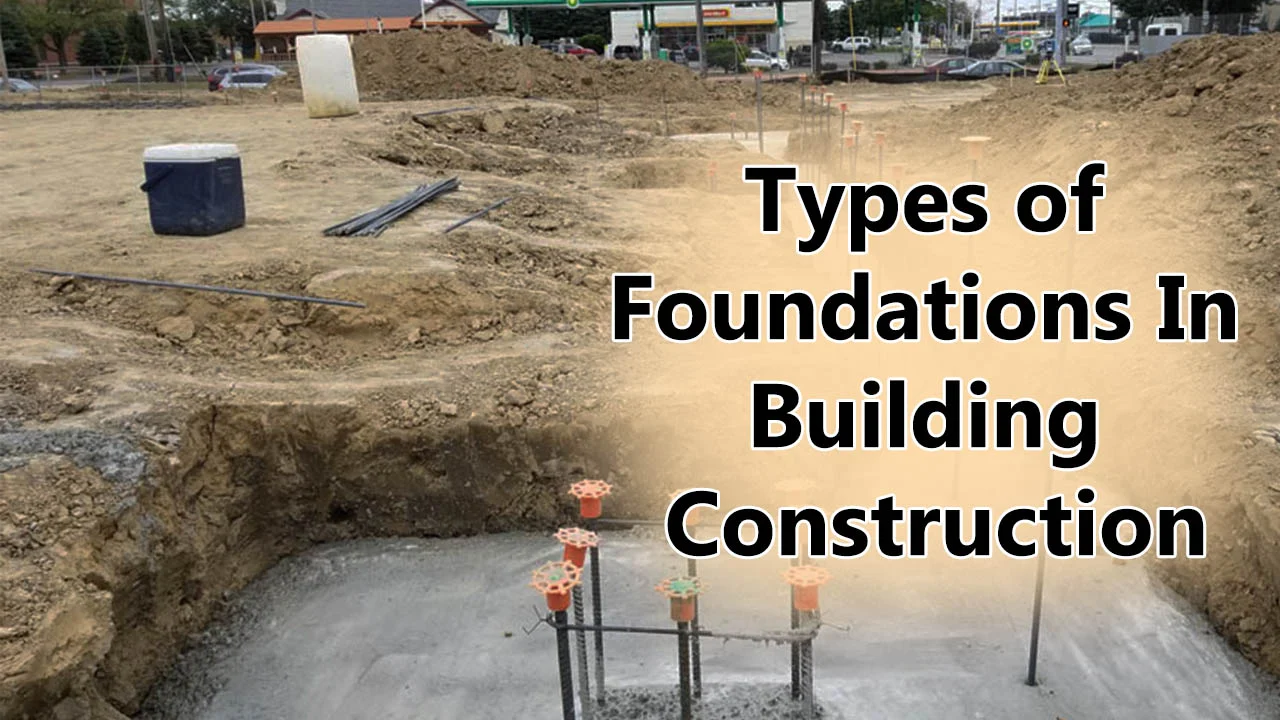Common Types of Foundations In Building Construction

Common Types of Foundations In Building Construction
In this article we will discuss the common types of foundations in buildings.Broadly speaking, all foundations are divided into two categories: shallow foundations and deep foundations. The words shallow and deep refer to the depth of soil in which the foundation is made. Shallow foundations can be made in depths of as little as 3ft (1m), while deep foundations can be made at depths of 60 – 200ft (20 – 65m). Shallow foundations are used for small, light buildings,while deep ones are for large, heavy buildings.The following Types of Foundations In Building Construction can be detailed below
Raft or Mat Foundations
Raft Foundations, also called Mat Foundations, are most often used when basements are to be constructed.
In a raft, the entire basement floor slab acts as the foundation; the weight of the building is spread evenly over the entire footprint of the building. It is called a raft because the building is like a vessel that ‘floats’ in a sea of soil.
Mat Foundations are used where the soil is week, and therefore building loads have to be spread over a large area, or where columns are closely spaced, which means that if individual footings were used, they would touch each other.
Shallow Foundations
Shallow foundations are also called spread footings or open footings. The ‘open’ refers to the fact that the foundations are made by first excavating all the earth till the bottom of the footing, and then constructing the footing. During the early stages of work, the entire footing is visible to the eye, and is therefore called an open foundation. The idea is that each footing takes the concentrated load of the column and spreads it out over a large area,so that the actual weight on the soil does not exceed the safe bearing capacity of the soil.
There are several kinds of shallow footings: individual footings, strip footings and raft foundations.
In cold climates, shallow foundations must be protected from freezing. This is because water in the soil around the foundation can freeze and expand, thereby damaging the foundation. These foundations should be built below the frost line, which is the level in the ground above which freezing occurs. If they cannot be built below the frost line, they should be protected by insulation: normally a little heat from the building will permeate into the soil and prevent freezing.
Individual Footings
Individual footings are one of the most simple and common types of foundations. These are used when the load of the building is carried by columns. Usually, each column will have its own footing. The footing is just a square or rectangular pad of concrete on which the column sits.
To get a very rough idea of the size of the footing, the engineer will take the total load on the column and divide it by the safe bearing capacity (SBC) of the soil. For example, if a column has a vertical load of 10T, and the SBC of the soil is 10T/m2, then the area of the footing will be 1m2. In practice, the designer will look at many other factors before preparing a construction design for the footing.
Individual footings are usually connected by a plinth beam, a horizontal beam that is built at ground or below ground level.
Pile Foundations
A pile is basically a long cylinder of a strong material such as concrete that is pushed into the ground so that structures can be supported on top of it.
Pile foundations are used in the following situations:
When there is a layer of weak soil at the surface. This layer cannot support the weight of the building, so the loads of the building have to bypass this layer and be transferred to the layer of stronger soil or rock that is below the weak layer.
When a building has very heavy, concentrated loads,such as in a high rise structure.
Pile foundations are capable of taking higher loads than spread footings.
There are two types of pile foundations, each of which works in its own way.
See More When And Where To Use Pile Foundation
End Bearing Piles
In end bearing piles, the bottom end of the pile rests on a layer of especially strong soil or rock. The load of the building is transferred through the pile onto the strong layer. In a sense, this pile acts like a column. The key principle is that the bottom end rests on the surface which is the intersection of a weak and strong layer. The load therefore bypasses the weak layer and is safely transferred to the strong layer.
Friction Piles
Friction piles work on a different principle.The pile transfers the load of the building to the soil across the full height of the pile, by friction. In other words, the entire surface of the pile, which is cylindrical in shape, works to transfer the forces to the soil.
To visualise how this works, imagine you are pushing a solid metal rod of say 4mm diameter into a tub of frozen ice cream. Once you have pushed it in, it is strong enough to support some load. The greater the embedment depth in the ice cream, the more load it can support. This is very similar to how a friction pile works. In a friction pile, the amount of load a pile can support is directly proportionate to its length.
In practice, however, each pile resists load by a combination of end bearing and friction.
Above all are basic Types of Foundations In Building Construction.
Collection of Civil Engineering Ebooks Click Here









